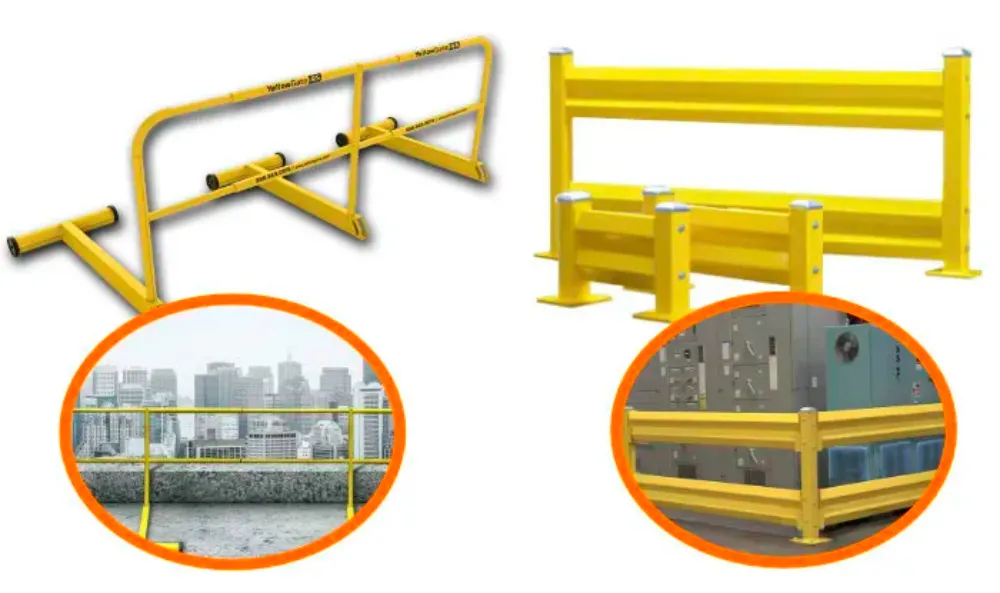Falls from rooftops and other heights are a leading cause of injury and death in the construction, manufacturing, and other industries.
Fall injuries not only cause suffering (or worse) to employees, but they also create an increased financial burden for their families and employers. Without safety barriers like guardrails and handrails, anyone working at a height of six feet or more is defenseless against a fall.
While guardrails and handrails sound similar and perform the same general function — fall protection — the actual definition and code requirements for each differ considerably.
Here’s a quick overview.

What Is a Guardrail?
Guardrails — also known as standard railings — are vertical barriers that protect employees and visitors against falls from elevated surfaces, alert workers to the presence of hazards, and prevent unauthorized access to restricted areas.
While guardrails can come in a variety of custom styles, they consist of top rails, intermediate rails, and posts assembled to prevent employee falls, as well as toeboards, which keep equipment, materials, and employees’ feet from slipping off the edge.
Unlike handrails, guardrails are designed to be life-saving devices around metal steps, landings, platforms, openings, accessible roof spaces, or other hazards.
What Is a Handrail?
While handrails promote safe movement, they are not intended to be life-saving devices.
Mounted to a wall or partition by brackets attached to its lower side, a handrail provides a supporting handhold for employees or visitors who might be disabled, have trouble walking, or otherwise prefer assistance when navigating stairs, ramps, slopes, or other surfaces.
Handrails are typically used with any stairway consisting of more than three risers. To learn more about stair parts, visit our guide to stair components.
| Handrail | Guardrail | |
|---|---|---|
| What Is It? | Handrails provide a handhold for support. This rail must be designed so people can grasp it firmly. The minimum clearance between it and any other object is 2.25 inches to keep everyone safe from harm while providing stability when moving around the workplace. | Guardrail systems are fall-protection railings that help keep people from falling off a walkway or other unprotected surfaces, and they are used in many different places. Guardrails are installed on buildings’ edges, decks, balconies, scaffolding, and work platforms. On roadsides or cliffs with drop-offs of various heights and around holes exposed by digging or blasting operations, these serve as ‘safety gates’ or warnings. Near the edge of dangerous areas where there are power transformers and substations, these rails prevent people from unknowingly touching them, leading to potential electrocution hazards. |
| OSHA Height Requirement | Minimum height is 30 inches. Maximum height is 38 inches. Height is measured from the leading edge of the stair tread to the top surface of the handrail. | Must withstand a force of at least 200 pounds applied in any downward or outward direction within two inches of any point along the top edge of the guardrail. The guardrail system must not bend to a height of less than 39 inches. |
| OSHA Strength Requirement | Must withstand a force of at least 200 pounds applied in any downward or outward direction within two inches of any point along the top edge of the handrail. | Must withstand a force of at least 200 pounds applied in any downward or outward direction within two inches of any point along the top edge of the guardrail. The guardrail system must not bend to a height less than 39 inches. |
Code Requirements for Guardrails and Handrails
Guardrails and handrails will keep your employees and visitors safe and help you comply with OSHA and IBC standards.
GUARDRAIL REQUIREMENTS
Per OSHA standard 1910.23 (c), guardrails are required as the main method of preventing employees from falling to lower levels. Any platform 4 feet or higher above a lower floor or the ground must be protected by a guardrail on all open sides. Guardrails must have vertical heights of 42 inches from the upper surface of the top rail to the floor, platform, runway, or ramp level.
Per Standard Directive 1-1.10, guardrails must consist of the aforementioned top rails, intermediate rails (“about halfway up”), and posts — or equivalent — and have a minimum vertical height of 36 inches to 44 inches. They must also have toeboards. All top and intermediate rails must be at least .25 inches in diameter or thickness.
Guardrails can be higher than 44 inches if the extra height does not compromise employee safety. An opening under the top rail that would allow a 19-inch (or larger) spherical object would be considered unsafe, and would require an additional intermediate rail.
IBC requirements call for guardrails 42” high.
HANDRAIL REQUIREMENTS
Per OSHA standard 1910.24, handrails are prescribed as fall protection. Standard railings are required on the open sides of all exposed stairways and stair platforms. Handrails must be provided on at least one side of closed stairways, and both railings and handrails must be installed in accordance with 1910.23.
These requirements are calculated according to stairway width and the number of closed sides for each flight of stairs having four or more risers. For example, on stairways more than 44 inches wide but less than 88 inches wide, there must be one handrail on each enclosed side and one stair railing on each open side.
The minimum clearance between handrails and other objects is 2.25 inches. Handrails must have the shape and dimension necessary to grasp firmly, and the ends of handrails and handrail systems must not present any projection hazards.
IBC requirements call for handrails of 34″ high on both sides of a stairwell.
| Guardrails | Handrails | |
|---|---|---|
| OSHA | Height: Top rail to walking-working surface should be around 42 inches – allows flexibility for +/-3 inches. Opening Limitations: OSHA requires a 21” midrail such that a 19” or larger spherical object cannot pass through the guardrail. Load Requirement: It should be to hold a load from a 200-pound weight that is pushing down or pulling outward within 2 inches of the top edge of the top rail. | Clearance: The minimum clearance between handrails and other objects is 2.25 inches. Projection Threats: There should be no projection threats at the extremities of handrails or their attached structures. Load Requirement: It should be to hold a load from a 200-pound weight that’s pushing down or pulling outward within 2 inches of the top edge of the top rail. |
| IBC | Height: Minimum of 42” above the leading edge of the tread or walking surface. Opening Limitations: Rails in IBC applications shall not have openings that allow passage of a sphere 4 inches in diameter from the walking surface to the required guard height. | Height: 34″ minimum; 38″ maximum – measured vertically above stair nosings and ramp surfaces. Stairway Entry: Intermediate handrails are required so that all portions of the stairway width required for egress capacity are within 30 inches of a handrail. Extension Requirement: 12″ horizontally beyond top stair riser – measure to the inside face of the handrail return. |
Load Requirements
If guardrails or handrails fail to meet structural load capacity, they can break or fail, creating a dangerous situation for employees and visitors.
According to IBC guidelines, top guardrails and handrails must be able to withstand a linear load of 50 pounds per linear foot (plf) per Section 4.5.1 of ASCE. They must also be able to handle a 200-pound concentrated load applied downward within two inches of the top edge of the top rail. IBC guidelines require that intermediate rails — defined as all rails except the actual guardrail or handrail — must be able to resist a concentrated load of 50 pounds.
OSHA requirements are similar, calling for guardrails and handrails to be able to withstand 200 pounds of pressure when applied to the structure. This strength and stability is crucial due to the regular wear and tear guardrails and handrails are subjected to in industrial settings.
Note: CAL-OSHA code, which was written to protect workers in the state of California, is more stringent than OSHA regarding guardrail protection and roof fall protection systems:
- Per CAL-OSHA code, railings can be 41 to 46 inches in height, which is a minimum of 2 inches taller than OSHA’s federal minimum. They can exceed the federal maximum by 1 inch.
- CAL-OSHA has a similar guideline in place for intermediate rails (or midrails) as federal requirements, calling for them to be “approximately halfway between the top rail and the floor, platform, runway, or ramp.”
- While CAL-OSHA follows OSHA concentrated force regulation of at least 200 pounds, it carries an additional component regarding the live load applied to a guardrail: “All guardrails and other permissible types, including their connections and anchorage, shall be designed for a live load of 20 pounds per linear foot applied either horizontally or vertically downward at the top rail.”
Bottom Line: Railings Save Lives
The number of fatal workplace falls has been on the rise in recent years, reaching an all-time peak in 2017.
While the number of regulations regarding guardrails and handrails can seem overwhelming, keeping up with them is crucial when it comes to protecting people from falls and ensuring a culture of safety in your facility.
